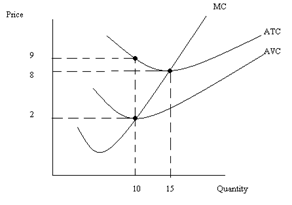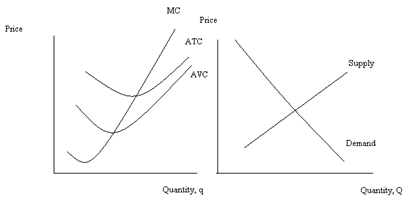Reference no: EM131018318
Homework 4-
1. Use the graph below of a perfectly competitive firm's cost functions to answer this set of questions.

a. In the short run, what is the fixed cost for this firm? Explain your answer fully.
b. Suppose this firm produces 15 units of output. What is the variable cost of producing this level of output? What is the firm's AVC of production when it produces 15 units of output. Explain your answer fully.
c. Suppose the market price of the good in the short-run is $9 per unit. What do you know about this firm's short-run profits, TR, TC, FC, VC, and level of production given this information? What do you predict will happen in the long-run in this market? (Hint: describe verbally, with numerical reference points, what you know about these different measures.)
2. Use the graph below of a perfectly competitive market and a representative firm in this market to answer this set of questions. Assume all firms in the market are identical.

a. Given the above graphs, identify on the graphs the short-run equilibrium price, P1; the short-run equilibrium market quantity, Q1; and the short-run firm quantity, q1. On the graph indicate the average total cost for the firm of producing its level of output; also shade in the area that represents profits and determine whether these profits are positive or negative.
b. From your work in (a), fill in the following statements with either "=", ">", or "<".
i. P _______ AFC
ii. TR _____VC
iii. TR _____TC
iv. Profit ______0
c. In the long run, holding everything else constant, what do you predict will happen in this industry?
d. Redraw the above graph and in this new graph show the long run adjustment of the market. Assume that market demand and the cost curves for the firms do not change. Label any shifting curves completely. Also label the new long run equilibrium price, P2; the new long run equilibrium market quantity, Q2; and the new long run equilibrium quantity for the firm, q2. Explain in words this long run adjustment process.
3. The profit maximization rule for a perfectly competitive firm states that the perfectly competitive firm will maximize its profits when it produces that quantity where marginal revenue equals marginal cost for the last unit produced and sold. In your own words explain why the firm is better off producing that quantity where MR = MC rather than that quantity where MR > MC or that quantity where MR < MC.
4. A perfectly competitive market has market demand that can be represented by the equation P = 200 - 2Q. Furthermore, you are told that all firms in the market are identical and that the total cost function and the marginal cost function for a representative firm are given by the following equations: TC = 32 + 20q + 8q2 and MC = 20 + 16q. There are 10 firms initially in this market.
a. Given the above information, what is the fixed cost for the representative firm? Explain your answer.
b. Find the market supply curve given the above information.
c. Given the above information and the market supply curve you found in (b), calculate the equilibrium price and quantity in this market in the short run.
d. If each firm is identical, how many units of output will each firm produce in the short run?
e. Calculate the representative firm's short run profits.
f. Given your calculation in (e), what do you predict will happen in the long run? Explain your answer.
g. Calculate the long run equilibrium price in this market. Then, assuming market demand does not change, calculate the long run equilibrium market quantity as well as the level of output for a representative firm. Finally, calculate the number of firms in this industry in the long run.
5. Suppose the market demand curve for a monopolist is given as P = 200 - 2Q. Furthermore, suppose the MC curve for the firm can be written as MC = 20 + 2Q. The firm's TC can be expressed as TC = 20Q + Q2 + 100. Use this information to answer this set of questions.
a. What is the profit maximizing price and quantity for this monopolist given the above information? Calculate the monopolist's profit.
b. Calculate the monopolist's consumer surplus (CS), producer surplus (PS), and deadweight loss (DWL).
c. Suppose demand increases by 90 units at every price. Find the equation for the monopolist's new demand curve. Then, calculate the new profit maximizing price and quantity for this monopolist given the new demand curve. Calculate the new level of monopoly profits.
d. Calculate the value of consumer surplus (CS'), producer surplus (PS'), and deadweight loss (DWL') for this monopolist given the information in (c).
6. Consider a natural monopoly with market demand
P = 100 - 10Q
and whose total cost curve and marginal cost curve can be expressed as
TC = 100 + 20Q + Q2
MC = 20 + 2Q
a. Write an equation for this natural monopoly's average total cost (ATC) curve?
b. Using the equation you wrote in (a) fill in the following table.
c. Draw a graph of this firm's demand curve, ATC curve, and MC curve. At what (Q, P) do MC and ATC intersect one another? Show how you found there coordinates. Is this (Q, P) pair a likely equilibrium in this market? Explain your answer fully.
d. Suppose this monopolist acts as a single price profit maximizing monopolist. Determine the monopolist's price, quantity, and profit with this scenario. Round your answers to the nearest hundredth.
e. Suppose this monopolist is regulated to produce the socially optimal amount of output (where P = MC for the last unit produced and sold). Given this regulatory decision, determine the monopolist's price, quantity, and profit. Round your answers to the nearest hundredth.
f. Suppose this monopolist is regulated to produce that quantity where profit is equal to zero. Given this regulatory decision, determine the monopolist's price, quantity, and profit. Round your answers to the nearest hundredth. HINT: TO FIND THE Q IN THIS QUESTION YOU WILL NEED TO MAKE USE OF THE QUADRATIC FORMULA!
Here's a quick review of the quadratic equation and the quadratic formula!
A quadratic equation can be written as
ax2 + bx + c = 0
In this question "x" will be "Q", the variable whose value we are trying to find.
Once you have an equation written in the above form, you will need to use the quadratic formula to solve for the value of x since the quadratic equation you will have found cannot be easily factored. So, here is the quadratic formula:
x = [- b ± (b2 - 4ac)1/2]/(2a)
This formula when used will give you two solutions: one of these solutions represents where ATC crosses the demand curve at a very high price and a very low price (this is not the point you are looking for)-discard this solution and use the other solution.
7. Consider a monopoly where the market demand curve is given by the equation
Q = 40 - 2P
To simplify the math of this problem let's assume this firm has fixed cost of $10 and that the firm's MC can be written as
MC = $2 per unit of output
a. Suppose this profit-maximizing monopolist acts as a single price monopolist. Determine the price the monopolist will charge, the level of output it will produce, the level of profits it will earn (be careful here-don't forget to incorporate those fixed costs!), the level of consumer surplus (CS), the level of producer surplus (PS), and the deadweight loss (DWL) in this market. (Hint: you may find it helpful to sketch a graph to guide your work. Also, don't forget to incorporate the fixed costs when calculating PS.)
b. Let's do a check on your calculations in (a). In this problem suppose the firm produced and sold the socially optimal amount of the good while practicing perfect price discrimination.
i. If the firm did this, what would the firm's total revenue equal? To calculate this answer you will need to think about what the socially optimal amount of the good is and what price(s) the firm would need to charge to sell this amount of the good assuming the firm was a perfectly price discriminating firm.
ii. If the firm did this, what would the firm's TC equal?
iii. Recall that total surplus (TS) is the area below the supply curve and above the demand curve. In this example to find TS we will also need to remember to include the fixed costs. If the firm produces the socially optimal amount of the good, what will TS equal?
iv. Go back to your answers in (a) and calculate the sum of (CS + PS + DWL). Does this sum equal the TS value you calculated in (iii)? If not, you have made an error in your calculations or in your logic! And, this implies you need to continue to think and work on this problem.
c. Compare the profits this monopolist earns as a single price monopolist versus a perfect price discriminating monopolist.
d. Does it benefit the monopolist to perfectly price discriminate? Explain your answer.
8. Let's return to the same monopolist we considered in the last problem. Recall this monopolist's demand curve is given by the equation:
Q = 40 - 2P
Also, recall that this firm's fixed cost of production is $10 and that the firm's MC can be written as
MC = $2 per unit of output
a. Quickly refer back to your earlier work and record the profit maximizing quantity, price and profits of this monopolist if the monopolist acts as a single price monopolist.
b. Now, suppose this monopolist decides to practice second degree price discrimination. It plans to continue to sell the original level of output at the initial price, but it now wants to offer more of the good at two other pricing levels. Suppose it decides to offer at the first new pricing level 10 additional units and at the second new pricing level 4 more units.
i. Draw a graph representing this new pricing arrangement where P1 is the first new pricing level and p2 is the second new pricing level. In your graph identify numerically the total level of output that corresponds to these new prices.
ii. Calculate the numerical values of P1 and P2.
c. Suppose the firm now charges three prices: the initial price it charged as a single price monopolist, P1, and P2. Calculate the firm's TR under this pricing scheme. Calculate the firm's TC given this pricing arrangement (don't forget those fixed costs!). Then, calculate the firm's profits.
d. Is it profitable for this firm to practice second degree price discrimination? Explain your answer.